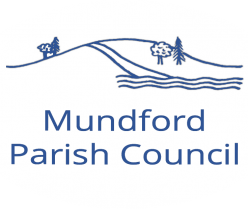About Mundford…
Now a Parish of approximately 2000 acres with 670 homes and population of around 1600, located almost at the mid-point between Kings Lynn, Bury St Edmunds and Norwich; Mundford enjoys a very rural position at the centre of the ‘Brecklands’ region and within the boundaries of the Thetford Chase Forest.
60,000 years ago when Neanderthals butchered mammoth in what is now Lynford Water, the middle Palaeolithic River Valley; through to 3000 years ago when Neolithic flint axes were produced by the thousands at nearby Grimes Graves, to be traded across Europe, Mundford was, and remains a major crossing point on the River Wissey.
Mund: from the middle English to mean “a natural hill appearing as if thrown up artificially-a regular or isolated hill” and; Ford: “a location where a river is shallow and the bottom has good footing making it possible to cross”
Both for locals and travellers alike, the “Mound by the Ford” was both instantly recognisable, and eagerly sought for on those arduous foot journeys through lands unfamiliar.
Pre-dating all settlements and manmade forests, the area must have attracted a population of some sort very early in its history, living off the abundant game in this wild area; and centred on the place to cross safely this treacherous area of river bog and marsh that probably stretched between the River Wissey and where Malsters Run is located today.
A very early “Guide” or “Ferryman” in times of flood could have made a living by collecting tolls and giving assistance, and may possibly have been one of the first professionals in this area of very poor agricultural land and opportunity. Pre dating the Doomsday book; the village was commemorated in 2007 by the fact that 1000 years had passed since it was first mentioned in written history. At that time; it, along with several other villages, was bequeathed to Ely Cathedral by Aelfwaru, a Saxon Queen who had converted to Christianity.
To mark the occasion in 2007, a large boulder and bronze plaque was placed on the village green, bearing all the details of the transaction.
Between 1857 and 1862, the imposing Lynford Hall was built in the neighbouring Parish of Lyndford for Stephens-Lyne-stephens (said at the time to be the richest commoner in England who’s fortune had been made by being the principle glassmaker to the King of Portugal) and his wife, the French Ballerina Yolande Duvernay. The house has been owned variously by different persons and organisations, including the Forestry Commission as a training centre, the Government during WWII as a hospital, and as a film set for such programs as ‘Allo Allo’, ‘Dad’s Army’ and ‘you rang m’lord’. During private ownership, guests have included several American Ambassadors, Ernest Hemingway and John Kennedy. The Estate owned most of Mundford village at the turn of the century, but in the 1920’s the Estate of 7718 acres was auctioned and the village was broken up into separate lots and sold to private individuals.
Initially Mundford was served by two windmills, an early smock mill situated on the West Tofts Road was auctioned at the Crown Hotel in 1859, dismantled and removed; complete with its pair of 4’0” French Millstones. The second mill was a four storey tower mill situated opposite the entrance to Impson Way which survived until demolition in 1972. This had been used as a watch tower during the war.
The village possesses several fine buildings, including the Crown Hotel, an Old Coaching Inn, St Leonards Church, a large rectory and several other piles. The centre of the village is now a conversation area.
Surrounded nowadays by the SSSI areas of forest and Breckland Heath, the area is renowned for its wildlife; including Stone Curlew, Nightjar, waxwings, Crossbills, buzzards and three types of Deer and much else. The Breckland also enjoys a unique flora that is highly specialised to the area.
Unlike many modern villages, Mundford is fortunate in that it retains a Village School, Village Hall, sports clubs, Post Office, Butchers, Newsagents, Hairdressers, Pub, Church and other facilities; thus retaining much more of a ‘community spirit’ than is usually found nowadays when many villages become ‘dormitories’ for people that work elsewhere, or have their souls destroyed by being ‘bought up’ as second homes and the owners are only there for a few weeks of the year.
Those privileged to live here, do so under the stewardship of a strong and active Parish Council who have embarked on the long term project of creating a ‘garden village’; with annual bulb planting project and continued support for floral projects within the village.
Written by Mr Martyn Eyles, Chairman to Mundford Parish Council 2007-2011
More information:
- Norfolk Heritage website
